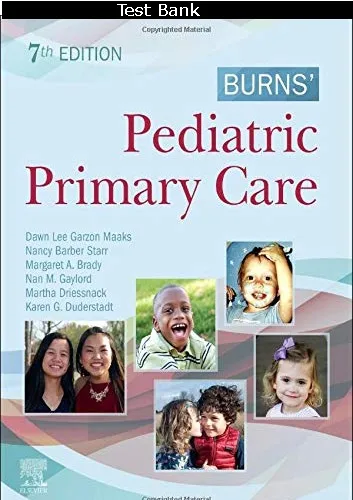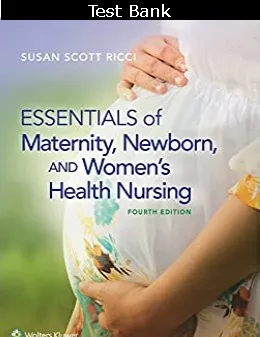Burns’ Pediatric Primary Care 7th Edition Test Bank
$55.00 Original price was: $55.00.$20.00Current price is: $20.00.
Digital item No Waiting Time Instant Download
Chapters: 46
Format: PDF
ISBN-13: 978-0323581967
ISBN-10: 032358196X
Publisher: Elsevier
Authors: Dawn Lee Garzon, Nancy Barber Starr, etc.
Description
Burns’ Pediatric Primary Care 7th Edition Test Bank
Table of Contents
- Unit I: Influences on Child Health and Child Health Assessment
1. Health Status of Children: Global and National Perspectives
2. Unique Issues in Pediatrics
3. Genetics and Child Health
4. Environmental Issues
5. Child and Family Health Assessment
6. Cultural Considerations for Pediatric Primary Care
7. Children with Special Health Care NeedsUnit II: Child Development
8. Developmental Management in Pediatric Primary Care
9. Developmental Management of Newborns
10. Developmental Management of Infants
11. Developmental Management of Early Childhood
12. Developmental Management of Middle Childhood
13. Developmental Management of Adolescents/Young AdultsUnit III: Child Health Supervision: Health Promotion and Health Protection
14. Introduction to Health Promotion and Health Protection for Children and Families
Section A. Behavioral-Mental Health Wellness
15. Behavioral and Mental Health Promotion
Section B. Biophysical Health Management
16. Breastfeeding
17. Nutrition
18. Elimination
19. Physical Activity and Sports
20. Sleep
- 21. Sexuality
Section C. Health Protection–Focused Care
22. Immunizations
23. Dental Health and Oral Disorders
24. Intentional and Unintentional Injuries: Injury Prevention and Child Maltreatment - Unit IV: Common Childhood Conditions and Disorders
Section A. Introduction to Child Disease Management
25. Acute/Chronic Disease Management and Principles of Diagnostic Testing
26. Prescribing Medications in Pediatrics
27. Complementary and Integrative Health in Pediatrics
28. Pediatric Pain and Fever Management
Section B. Disease Management
29. Perinatal Disorders
30. Mental Health Disorders
31. Infectious Diseases
32. Common Genetic Disorders
33. Atopic, Rheumatic, and Immunodeficiency Disorders
34. Dermatologic Disorders
35. Eye and Vision Disorders
36. Ear and Hearing Disorders
37. Respiratory Disorders
38. Cardiovascular Disorders
39. Hematologic Disorders
40. Gastrointestinal Disorders
41. Genitourinary Disorders
42. Gynecologic Disorders
43. Musculoskeletal Disorders
44. Injuries and Toxic Exposures
45. Endocrine and Metabolic Disorders
46. Neurologic Disorders
Chapter 01: Health Status of Children: Global and National Perspectives
Garzon Maaks: Burns’ Pediatric Primary Care, 7th Edition
MULTIPLE CHOICE
1. Which region globally has the highest infant mortality rate?
a. Indonesia
b. Southern Asia
c. Sub-Saharan Africa
d. Syria
ANS: B
Although Sub-Saharan Africa and Southern Asia together account for 77% of the infant
mortality rate globally, Southern Asia has the highest infant mortality rate (39%) in the world
followed closely by Sub-Saharan Africa (38%).
c. Vaccinations
d. Water purification
ANS: C
Rotavirus is the most common cause of diarrhea globally and Strep pneumonia is the leading
cause of pneumonia, and together these are the leading infectious causes of childhood
morbidity and mortality globally. Both are vaccine-preventable diseases. Antibiotics to treat
pneumonia, optimal nutrition, and clean water all help to reduce morbidity and mortality, but
vaccination prevents the diseases from occurring.
3. Which statement correctly reflects the health status of children in the United States?
a. Globalism has relatively little impact on child health measures in the U.S.
ANS: B
Obesity rates are a major concern for child health in the U.S. but recently have stabilized at
8.9%. Globalism has an increasing effect on child health in the U.S. The rate of household
poverty in the U.S. is higher than in other economically developed nations. Young children
who attend preschool or day care have lower food insecurity.
4. The primary care pediatric nurse practitioner understands that what major child health
outcome is dramatically associated with worldwide climate change?
a. Housing
b. Education
c. Nutrition
2. The primary care pediatric nurse practitioner understands that, to achieve the greatest world-
wide reduction in child mortality from pneumonia and diarrhea, which intervention is most
effective?
a. Antibiotics
b. Optimal nutrition
abirb.com/test
b. Obesity rates among 2- to 5-year-olds have stabilized below Health People 2020
goal of 9.4%.
c. The rate of household poverty is lower than in other economically developed
om
d. nYoung children who atte ations. nd preschool abirb.com/test or day care have higher food insecurity.
prepthenurse.com
d. Pollution
ANS: C
There is growing evidence that climate change is having a dramatic effect on food crops that
leads to food distribution issues and food insecurity among families.
5. When providing well child care for an infant in the first year of life, the primary care pediatric
nurse practitioner demonstrates an understanding of current guidelines when taking what
action?
a. Focusing less on development and more on illness prevention and nutrition.
b. Following guidelines established by the Bright Futures publication.
c. Scheduling well-baby visits to coincide with key developmental milestones.
d. Seeing the infant at ages 2, 4, 6, and 12 months when immunizations are due.
ANS: C
In the most recent AAP Recommendations for Preventive Pediatric Health Care, there is a
greater emphasis on behavioral and developmental issues and a recommendation that well
child care be based on child and family development rather than the periodicity of
immunization schedules.
prepthenurse.com
Chapter 02: Unique Issues in Pediatrics
Garzon Maaks: Burns’ Pediatric Primary Care, 7th Edition
MULTIPLE CHOICE
1. What is the foundational basis of patient-and-family centered care (PFCC)?
a. The family is to be considered when patient care is being planned
b. The patient has ultimate control over health care decisions
c. A family member acts as the patient’s surrogate decision makes
d. The patient is the focus of the primary care provider’s attention
ANS: B
While all options are correct statements, the foundational basis of PFCC is the patient has
ultimate control over health care decisions.
2. Which assessment question best demonstrates the primary care provider’s understanding of
effectively dealing with the greatest challenge to providing dual patient care?
a. To the parent: “Do you feel comfortable providing in-home care for your child?”
b. To the child: “When would you like your physical therapy sessions to be
scheduled?”
c. To the parent: “What are your feelings about going to family therapy to help with
this transition?”
d. To the child: “When did you first notice the pain in your knees?”
ANS: B
One of the greatest challenges is how to access, acknowledge, and include the child’s voice,
which is often lost and/or overridden in health care. By directly asking the child their opinion
or feelings, the PCP is providing for the child’s voice to be heard and acknowledged. None of
the other options addresses that need.
3. Which intervention best demonstrates a pediatric nurse primary care pediatric nurse
practitioner’s understanding of effective pain assessment?
a. Providing instructions regarding the pain assessment tool to parents of all
newly admitted children
ANS: B
In the past, clinicians and researchers have relied on adult-developed and adult-centered tools
and approaches, which have been “adapted” for use with children by adding pictures and/or
simpler language. There is increasing realization that data from adapted, adult-centered
models have has not adequately captured the voices and/or experiences of children. Engaging
in the development of an assessment tool that is child focused is the best demonstration of
understanding. All other options rely on adaptation of adult-centered tools or focus on
standard pain management related interventions.
abirb.com/test
b. Assisting in the developmnt of a e child-centered pain assessment scale
c. Reviewing the documentation regarding the child’s pain assessment 30 minutes
after analgesic medication was administered
d. Explaining to both the child and the parents why pain medication will be delivered
intravenously





Be the first to review “Burns’ Pediatric Primary Care 7th Edition Test Bank”